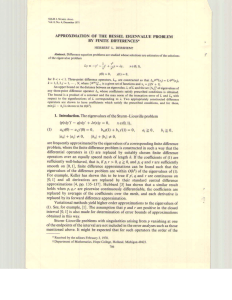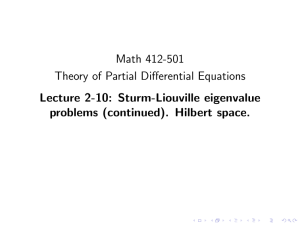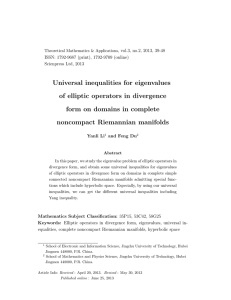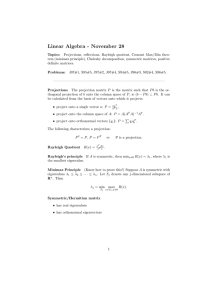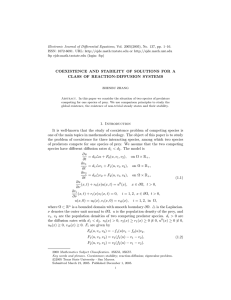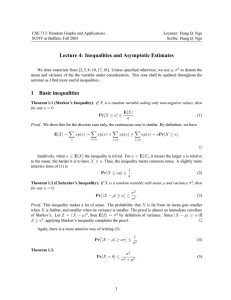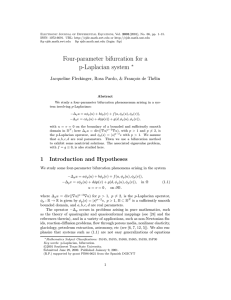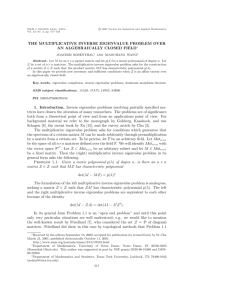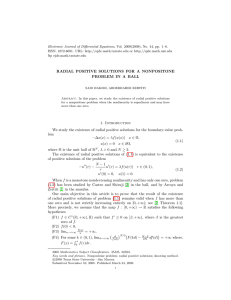Document 10943916
advertisement
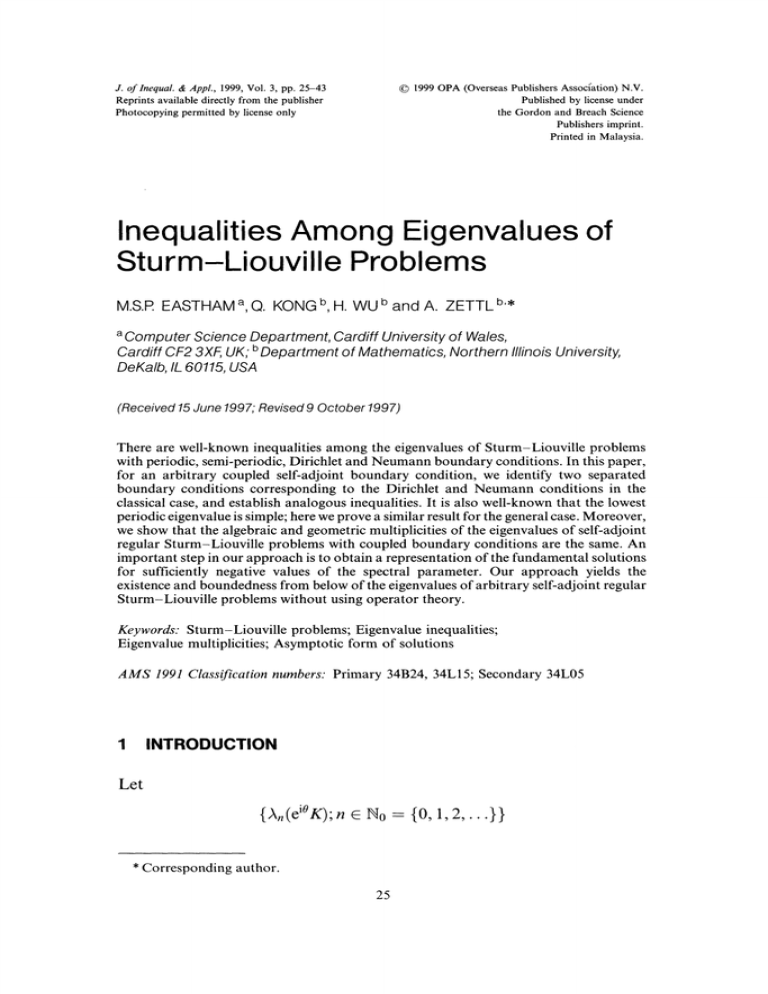
(C) 1999 OPA (Overseas Publishers Association) N.V.
Published by license under
the Gordon and Breach Science
Publishers imprint.
Printed in Malaysia.
J. oflnequal. & Appl., 1999, Vol. 3, pp. 25-43
Reprints available directly from the publisher
Photocopying permitted by license only
Inequalities Among Eigenvalues of
Sturm-Liouville Problems
M.S.R EASTHAM a, Q. KONG b, H. WU b and A. ZETTL b,,
a Computer Science
Department, Cardiff University of Wales,
Cardiff CF2 3XF, UK; b Department of Mathematics, Northern Illinois University,
DeKalb, IL 60115, USA
(Received 15 June 1997; Revised 9 October 1997)
There are well-known inequalities among the eigenvalues of Sturm-Liouville problems
with periodic, semi-periodic, Dirichlet and Neumann boundary conditions. In this paper,
for an arbitrary coupled self-adjoint boundary condition, we identify two separated
boundary conditions corresponding to the Dirichlet and Neumann conditions in the
classical case, and establish analogous inequalities. It is also well-known that the lowest
periodic eigenvalue is simple; here we prove a similar result for the general case. Moreover,
we show that the algebraic and geometric multiplicities of the eigenvalues of self-adjoint
regular Sturm-Liouville problems with coupled boundary conditions are the same. An
important step in our approach is to obtain a representation of the fundamental solutions
for sufficiently negative values of the spectral parameter. Our approach yields the
existence and boundedness from below of the eigenvalues of arbitrary self-adjoint regular
Sturm-Liouville problems without using operator theory.
Keywords." Sturm-Liouville problems; Eigenvalue inequalities;
Eigenvalue multiplicities; Asymptotic form of solutions
AMS 1991 Classification numbers: Primary 34B24, 34L15; Secondary 34L05
INTRODUCTION
1
Let
{,,(eiK);n E No {0, 1,2,...}}
Corresponding author.
25
M.S.P. EASTHAM et al.
26
denote the eigenvalues, listed in non-decreasing order, of the SturmLiouville problem (SLP) consisting of the equation
-(py’)’ + qy Awy
on
J-(a,b),
(1.1)
and the coupled self-adjoint boundary condition (BC)
Y(b)
eiKY(a),
(1.2)
where
Y-(Y)
pyp
KSL(2,R)-" {
detK_l},
(kllkl kl2);kijR,
k
i-x/Z1, -Tr<0<Tr,
-oo<a<b<oo,
K-
(1.3)
and
1/p,q, wEL(J,), p>0,
w>0a.e, onJ.
(1.4)
Here denotes the set of real numbers, L I(J,) the space of real
valued Lebesgue integrable functions on J.
According to a well-known classical result (see [3,2] for the case of
smooth coefficients, and [7] for the general case), we have the following
inequalities for K--/, the identity matrix:
A <_ Ao(I)< Ao(eiI) < Ao(-/) <_ {A,AN}
_< A, (-I) < A, (eiI) < A, (I) _< {AD, A2TM}
_< A2(I)< A2(eiI) < A2(-I) _< {AzD, A}
_< A3(--I) < A3(ei/) < A3(I) _< (A,A4N} _<’",
-
A
(1.5)
where 0 E (-Tr, 70 and 0 0. In (1.5), A and
denote the nth Dirichlet
and Neumann eigenvalues, respectively, and the notation {A,A}
means either of
and A1y.
Inequality (1.5) has been extended in [7] from K-- I to
A
K-
(c 1/c0)
0
c>0,
INEQUALITIES AMONG EIGENVALUES
27
and in [1] to a larger class of K, including
K=
0
1/c
c>0, h_<0.
Here we find an analogue of (1.5) for an arbitrary K E SL(2, R). A key
feature of this result is the identification of two separated BCs whose
in (1.5). This feature plays an
eigenvalues play the role of An and
important role in the forthcoming update of the FORTRAN code
SLEIGN2 where it is used not only to bracket the coupled eigenvalues
but also to determine their indices.
As a consequence of these general inequalities we show that for
any K SL(2,N) either A0(K) or A0(-K) is simple; thus extending the
classical result that the lowest periodic eigenvalue is simple, to the
general case of arbitrary coupled self-adjoint BCs. Here simple refers
to both the algebraic and geometric multiplicities, since we will show
below that the two multiplicities are equal for coupled BCs.
Our proof of the general inequalities analogous to (1.5) actually yields
a new proof of the existence and boundedness from below of the
eigenvalues of arbitrary coupled self-adjoint regular SLPs without using
the theory of self-adjoint operators in Hilbert space. For separated BCs
such a proof is provided by the Prfifer transformation.
Our method of proof relies heavily on the approach in the book of
Eastham [3] and on an asymptotic form of the fundamental solutions
of (1.1) for sufficiently negative A.
In Section 2 we introduce our notation and discuss some basic results.
Our main results, the general inequalities and a representation of the
fundamental solutions from which the asymptotic form is deduced, are
stated in Section 3; the proofs are given in Section 5 after discussions
of the characteristic function and multiplicities in Section 4.
A
2
NOTATION AND PREREQUISITE RESULTS
Throughout this paper, for the SLP consisting of (1.1) and (1.2) we
assume that (1.3) and (1.4) hold. It follows from the well-known theory
of regular self-adjoint SLPs that the SLP consisting of (1.1) and (1.2) has
an infinite, but countable, number of only real eigenvalues which can
be ordered to form a non-decreasing sequence (with only the double
M.S.P. EASTHAM et al.
28
eigenvalues appearing twice). This sequence is bounded from below,
but not from above.
In general, the nth eigenvalue does not depend on the BC continuously, see [4]. Nevertheless, each simple eigenvalue is on a locally
unique continuous branch of simple eigenvalues, while each double
eigenvalue is on two locally unique continuous branches of eigenvalues.
See [5] for details.
Let u and v be the fundamental solutions of (1.1) determined by the
initial conditions
u(a, A)
0
v [’] (a, A),
u [’] (a, A),
v(a, A)
AC.
(2.1)
Here and below y[ll=py for any solution y of (1.1). Note that the
condition (1.4) guarantees that y, yIll exist and are absolutely continuous on the compact interval [a, b] for any solution y of (1.1). Thus the
BC (1.2) is well-defined.
For any fixed K E SL(2, IR) and all A E C we define
(2.2)
(2.3)
(2.4)
(2.5)
(2.6)
(2.7)
Note that
D()
a (/)+ B2(/),
(A) 2(A).
(A)
(2.8)
Let
(/./)
.(t. )
v[1](t .)
u[ll (t, A)
)
(2.9)
Then (t, A) is the fundamental matrix solution of
Y(t)
[P(t)- AW(t)]Y(t),
Y(a)
I,
(2.10)
INEQUALITIES AMONG EIGENVALUES
29
where
0
q
w 0
Also note that
)
C.
(2.11)
The function usually used to characterize the eigenvalues is
det(eiK (b, A))
2cos0- D(A),
see [8, Lemma 4.5, p. 48]. This identity implies the following result.
LEMMA 2.1 A number is an eigenvalue of the Sturm-Liouville
problem consisting of (1.1) and (1.2)/f and only if
D(A)
2cos0.
(2.12)
Moreover, we have the following lemmas:
LEMMA 2.2 A number A is an eigenvalue of the Sturm-Liouville
problem consisting of (1.1) and (1.2) of geometric multiplicity two if
and only if
eiK (b, ,).
(2.13)
In this case, 0 0 or 0---7r.
Proof See [6, Theorem 3.1].
LEMMA 2.3 For the Sturm-Liouville problem consisting of (1.1) and
(1.2) we have
,X(eiK)
A.(e-iK)
(2.14)
.for any 0 E (-Tr, 7r] and n No. Furthermore, if z is an eigenfunction of
An(eiK), then its complex conjugate is an eigenfunction of A,(e-iK).
M.S.P. EASTHAM et al.
30
Proof Note that (2.14) follows from Lemma 2.1. The "furthermore"
statement can be verified by a direct substitution.
3
MAIN RESULTS
In this section we state our main results: general inequalities among
eigenvalues of SLPs and a representation of the fundamental solutions
for sufficiently negative A. We believe that the latter result, which
will be stated first and is needed for the proof of the former, is of
independent interest. In this section we make no distinction between
algebraic and geometric multiplicities because these are shown to be
equal in Theorem 4.2.
There exist Ao E
THEOREM 3.1
a:
[a,b]
x
,
k > 0 and a continuous function
(-cx, A0]
[0, c)
such that a(t, A) is decreasing in A for each (a, b], at(t, A) exists a.e. on
[a, b]for each A (-cx, Ao], (pa’)(t, A) p(t)at(t, A) is continuous on [a, b]
for each A (-, Ao], and
lim
a(t,A)
,
lim p(t)at(t,A)
(a, b]. Moreover, for the fundamental solutions
(1.1) we have
for each
v(t, A)
v[1] (t, A)
u and v
kcosh(a(t,A)),
kp(t)at(t, A) sinh(a(t, A)),
sech2(a(s’ A)) ds,
v(t, A)
f’ sech2((s,
v[1].t,A. ft
on [a, b] x
(3.1)
))1
ds+
of
(3.2)
(3.3)
(3.4)
sech((t,A))
(-, Ao], where the values of the right hand sides
(3.5)
at a are
defined by continuity.
For K SL(2, ) we consider the separated BCs
y(a)
O,
k22y(b)
kl2y[](b)
O,
(3.6)
INEQUALITIES AMONG EIGENVALUES
31
and
y[1](a)
k21y(b)
0,
ky[1](b)
(3.7)
0.
Note that (k22, k12) (0, 0) (k21, k 1) since det K 1. Therefore, there
exist an infinite number of eigenvalues for each of the BCs (3.6) and
(3.7). Let {#n,n E No} denote the eigenvalues of (3.6) and denote by
{Un, n No} the eigenvalues of (3.7). How are #n and un related to (K),
An (-K) and ,n (eiK)? This question is answered by the following result.
A
THEOREM 3.2 Let K SL(2, ).
(a) If k >0 and k12 < 0, then Ao(K)
0 7 O, we have
is simple, and for any 0 e (-Tr, 70,
uo _< Ao(K) < Ao(eiK) < Ao(-K)
<_ A(-K) < Al(eiK) < A(K)
< Az(K) < Az(eiK) < Az(-K)
_< A3(-K) < A3(eig) < A3(K)
_< {#o, ul}
_< {1,/2}
< {#2, u3}
_< {#3,//4} 5"". (3.8)
(b) If kl <_ 0 and k12 < 0, then Ao(K) is simple, and for any 0 e (-Tr, 70,
0 O, we have
/o(K) < o(eiK) </o(-K) _< {#0, o}
<_ 1 (-K) </1 (ei0K) < )1 (K) <_ {#1, t,’l }
<_ ,2(K) < ,2(eiK) < ,2(-K) _< {#2, t,’2}
< k3(-K) < ,k3(eiK) < A3(K) <_ {#, u3} <_....
(3.9)
(c) If neither case (a) nor case (b) applies to K, then either case (a) or case
(b) applies to -K.
COROLLARY 3.1 Let )n denote the nth eigenvalue of an arbitrary selfadjoint, separated or coupled, real or non-real, boundary condition, and let
XOn denote the nth Dirichlet eigenvalue. Then
A, <
,X,
n
No.
(3.10)
M.S.P. EASTHAM et al.
32
FIGURE
The graph illustrating the inequalities in (3.9) is the same except that
moves to the position of/]n + for all n E N0.
This is well-known in the case of separated boundary conditions
and the coupled case follows from Theorem 3.2.
Proof
COROLLARY 3.2 Let K E SL(2,IE) with either k > 0 and k]2 <_ 0 or
k <_ 0 and k12 < 0. If AZn+ I(K) is simple, where n No, then so is
’2n + 2(K). In particular, if K has a double eigenvalue, then the first double
eigenvalue of K is preceded by an odd number of simple eigenvalues.
By Theorem 3.2, for any K SL(2,IE), either A0(K) or A0(-K) is
simple. The inequalities in (3.8) are illustrated in Fig. 1.
4
THE CHARACTERISTIC FUNCTION D(A)
In this section, for the function D(A) defined by (2.2), we compute D’(A),
establish some identities involving D(A) and D’(A) and show that the
geometric and algebraic multiplicities of the eigenvalues of regular selfadjoint SLPs are the same. Some properties of #, and un are obtained
thereafter.
LEMMA 4.1 For any A
D’(A)
we have
[A(A)u2(s, A) B(A)u(s, A)v(s, A)
C(A)v2(s, A)]w(s) ds,
(4.1)
INEQUALITIES AMONG EIGENVALUES
33
b
[2C(A)v(s, ) -I- B(/)u(s, ))]2W(S) ds
4C(A)D’(A)
u2(s, ))w(s) as,
[4 D2(,)]
[2A(A)u(s,A) B()v(s,A)]2w(s)ds
4A(,)D’(3,)
+ [4 D2()]
Proof Let
(4.2)
2(s, )w(s) ds.
(4.3)
(t,))= (d/d))q(t, ). From (2.9) it follows that
(P
) W)
W,
,x (a, )
0.
This and the variation of parameters formula imply that
Below we abbreviate the notation by omitting
as well as the integration argument s. Since
D()
,
and, in some cases, b,
trace K-1 (b, )
B1 (,) -+- B2(A)
by (2.11), we have that
D’())
trace K-l,.x(b, ))
-trace
=-trace
K -1 (b, )-1 (s, ) W(s)b(s, ) ds
( B2A
B1
-1 [1]
0)(v
=-traCefab( -B2uv+Cv2,
W
0
V [1]
v
ds
U[I] (S)
*
-Au2
-+- B1 uv
b
[Au2 + (B2 B)uv- Cv2lw(s)ds,
which together with (2.8) confirm (4.1).
w(s) ds
M.S.P. EASTHAM et al.
34
To establish (4.2) and (4.3), from (2.11) and (2.8) we obtain
B1B2 AC- det(K-la)
1,
and
4
D2
(B1 + B2) 2 4 (B1 B2) 2 4B1B2
4(1 9192) B2 -(4AC + B2).
4
Thus,
b
4CD
[4ACu2 4BCuv 4C2v2]w ds
[-(2Cv + Bu) 2 + (4AC + B))u2]w as
(2Cv + Bu)Zw ds- (4 D 2)
u2w ds,
i.e., (4.2) holds. The identity (4.3) can be verified similarly.
COROLLARY 4.1
and D’(,) 7 O.
Proof
If ) E R satisfies ID()I < 2,
then A()O
O, C(A) 0
These are direct consequences of (4.2) and (4.3).
LEMMA 4.2 Let #n and un be defined as in front of Theorem 3.2. Then
(i) C()) 0 tf and only if
# for some n No. For n No, u(., #)
is an eigenfunction of #n, and this eigenfunction is unique up to
constant multiples;
(ii) A(,)-- 0 if and only if / u for some n
No. For n No, v(., u) is
an eigenfunction of u, and this eigenfunction is unique up to constant
multiples;
(iii) For
# and for/ u,, n No, we have
(a) D2() > 4,
(b) Bi(/) 7 O,
1,2, and B(/)
u(b,#)B2(#)
v(b, ln)B (ln)
1/B2(A). Moreover,
k2,
kll,
n
No;
n
No.
(4.4)
(4.5)
INEQUALITIES AMONG EIGENVALUES
35
Proof Parts (i) and (ii) follow from the definitions of C(A) and A(A),
respectively; Part (iii(a)) is a consequence of (4.2) and (4.3).
To prove (iii(b)), note that A(A) 0 for A un and C(A) 0 for A
n E N0. Thus we get from (2.11) for such A that
#n,
det(K-l(b, A)) BI(A)B2(A).
To complete the proof we note that
F [1] (b,/in)u(b,
v(b,/in)U [1] (b,/in)
1.
This together with
kl2u[1]( b,/In) C(/in)
k22u(b,
0
imply that
u(b,/in)
-1
0
-k12
k12
B2 (/in)
i.e., (4.4) holds. In the same way we can establish (4.5).
Remark The existence and basic properties of the eigenvalues for
separated self-adjoint BCs can be established using the Prfifer
transformation. Lemmas 2.1 and 4.2, together with the continuity of
D(A), provide a new and elementary proof of the existence of the
eigenvalues for the coupled self-adjoint BCs. The boundedness from
below of the eigenvalues for a fixed coupled self-adjoint BC follows
from Theorem 3.1. Therefore, the existence and boundedness from
below of the eigenvalues for an arbitrary self-adjoint regular SLP can be
established without reference to operator theory.
THEOREM 4.1 Let 0 0 or 0
(a) Let A be an eigenvalue of the Sturm-Liouville problem consisting of
(1.1) and (1.2) of geometric multiplicity two. Then D’(A)=0.
(b) Let A be an eigenvalue of the Sturm-Liouville problem consisting of
(1.1) and (1.2), and assume D’(A)=0. Then A
geometric multiplicity two.
is an eigenvalue
of
M.S.P. EASTHAM et al.
36
Proof Assume that 0 =0. By Lemma 2.2 and (2.11), A is a double
eigenvalue of K if and only if A(A) C(A) 0 and Bl(A) B2()) 1.
(a) Suppose A is a double eigenvalue of K. Then A(A)= C(A)= 0 and
B(A) Bl(A) B2(A) 0. Hence, D’(A) 0 by (4.1).
(b) Suppose A is an eigenvalue of K and D’(A) 0. Then, by Lemma 2.1,
D(A) 2. From (4.2) and (4.3) we get
0.
Since
B1 (,)
B2(,)
B(A)
0 and B, ()
+ B2() D()
2,
it follows that Bl(A)= B2())-- 1. Thus, A is a double eigenvalue of K.
The case 0 7r can be established by replacing K by -K in the above
argument.
THEOREM 4.2 The algebraic and geometric multiplicities of the
eigenvalues of regular self-adjoint Sturm-Liouville problems with coupled
boundary conditions are the same.
If the coupled BC is non-real, i.e., 0 :/: 0, 7r, then the eigenvalues
have geometric multiplicity one by Lemma 2.2. On the other hand, they
have algebraic multiplicity one according to Corollary 4.1. Thus, the
two multiplicities are equal in this case.
If the coupled BC is real, then Theorem 4.1 implies that an eigenvalue
has geometric multiplicity one if and only if its algebraic multiplicity is
one. Thus, it suffices to show that if A, is an eigenvalue of geometric
multiplicity two, then its algebraic multiplicity does not exceed two, i.e.,
D"(A,) 0. By Lemma 2.2, we may assume that 0 0 and K= (b, A,).
Using the notation of Lemma 4.1 and noting that
Proof
=
b- Wg;
( r2W
-uvw
-u2w
UrW
we get
D’(A)
trace
(b,A,)-(b,A)
uvw
--r2W
)
INEQUALITIES AMONG EIGENVALUES
37
and
D"(A)
trace
+ trace ,(b, A,)-(b, A)0
trace
V"(A,)
trace
-
(b,,)-l(b,)Oa
uvw
(s,A) ds
ulw
a ulw
_f v2w
f u2w
_f uvw
f uvw f2 uw
(b, ,)-(b, )
+trace
uZw
uvw
2w
(b,A,)-l(b,A)
_f2 vw _fuvw
f2 uw
2
u(s,a,)w(s)ds
v(s,a,)w(s)ds
0
by the Cauchy-Schwarz inequality. Therefore, D"(,)< 0 since u and
are linearly independent.
THEOREM 4.3 Suppose 0 0 or 7r. Then an eigenvalue A of the SturmLiouville problem consisting of(1.1) and (1.2) is double if and only if there
exist n, rn E Ito such that A #n Urn, where #n and Um are defined in front
of Theorem 3.2.
Proof Assume A is a double eigenvalue of the SLP consisting of (1.1)
and (1.2). From the proof of Theorem 4.1 we see that A(A)= C(A)=0.
From (2.3) and (2.7) we have
k21 v(b, A) k viii (b, A)
0
(4.6)
kl2u [1] (b, A)
0.
(4.7)
and
k22u(b, A)
This means that A =//m for some rn
N0 and A
#n for some n
No.
M.S.P. EASTHAM et al.
38
Assume A--#n--l/m for some n,m E N0. From A--#n we get that
u(t,A)=u(t,#n) is an eigenfunction of ]An and hence satisfies (4.7).
Therefore, C(A)=0. In the same way, A(A)--0 follows from A--l/m.
Noting that 0- 0 or 7r implies that De(A)--4 by Lemma 2.1, and from
(4.2) we have that B(A)--0. Then D’(A)= 0 by (4.1), and A is a double
eigenvalue of the SLP consisting of (1.1) and (1.2) by Theorem 4.1.
COROLLARY 4.2 Suppose 0 0 or 7r. Let Ak and Ak + be eigenvalues of
the Sturm-Liouville problem consisting of (1.1) and (1.2). Then there
exist n, m No such that
{JAn, l/m)
Ak
Ak+l,
where ]An and 1,/m are defined & front of Theorem 3.2.
Proof If one of A and A +1
from Theorem 4.3. If both
is double, then the conclusion follows
are simple, noting that
A and Ag +
DZ(Ak) DZ(Ak+l)
4 and
D’(Ak)D’(Ak+I) < O,
from (4.2) and (4.3) we have that
C(Ak) C(Ak+I) <_ 0 and A(A)A(Ak+I) _< 0.
By the continuity of the functions C(A) and A(A), each of them has a
A + 1]. Then the conclusion follows from Lemma 4.2.
zero on [Ak,
It is seen from the definitions of ]An and l/n that they are functions of
K. The next lemma is about the continuous dependence of ]An(K) and
l/n(K) on K for K SL(2, ). See [4] for its proof.
LEMMA 4.3 For each fixed n No, ]An(K) and l/n(K) are cont&uous
functions on the sets
/El
{K SL(2,); kl > 0, k2 <_ 0)
K2
{K SL(2,); kll _< 0, kl2 < 0}.
and
Moreover, when K changes continuously from lto 1E2, l/o(K) disappears
at -cx when k--0 and l/n(K) changes to l/n-l(K) along a continuous
INEQUALITIES AMONG EIGENVALUES
39
eigenvalue branch, n 1,2,... On the other hand #n(K) is a cont&uous
eigenvalue branch for fixed n, n E I%.
5
PROOFS OF THE MAIN RESULTS
Proof of Theorem 3.1 Consider the boundary value problem consisting of (1.2) and the BC
(py’)(a)
(py’)(b)
O.
Let Ao be the smallest eigenvalue of this Neumann problem. Then
v(., Ao) is an eigenfunction for Ao. Hence v(., Ao) has no zero on [a, b].
So, there exists k >0 such that v(t, Ao)>_ k for
[a,b]. Denote by
q5 (t, A) (0, 70 the Prfifer angle for fit, A), i.e.,
h(t, A)
arccot
v[ll(t’ A)
(5.1)
v(t, A)
Then for E (a, b] and A <_ Ao, the Sturm Comparison Theorem implies
that q5 (t, A) _< q5 (t, Ao) since b (a, A) q5 (a, Ao) 7r/2. Hence we have
v’(t,A)
v(t,
>- v’(t, Ao)
for t
(a,b]
a.e. A
< Ao,
(5.2)
as long as fit, A) > 0, which implies that v(t, A) _> v(t, Ao) > k for
(a, b]
and A < A0. In the same way we see that v(t, A) is strictly decreasing in A
on (-, A0] for each fixed E (a, b].
There is a unique a’[a, b] (-, A0] [0, ) determined by (3.2)
which is continuous. Moreover, a(t, A) is decreasing in A on (-, A0] for
each t(a,b], at(t,A) exists, and p(t)at(t,A) is continuous. By the
reduction of order formula we see that u satisfies (3.4) and v[l,u []
satisfy (3.3), (3.5), respectively. We only need to show that (3.1) holds
for (a, b].
From the theory of the Prtifer transformation (see [7]), we know that
for b defined by (5.1), lim_
b (t, A) 0 for (a, b]. So,
lim
-
for
(a, b]
M.S.P. EASTHAM et al.
40
lim p(t)at(t, A) tanh(a(t, A))
for E
oc,
(a, b].
Note that 0 _< tanh(a(t, A))<_ 1, we get that
lim
p(t)at(t,A)
(a,b].
for
o,
(5.3)
Now, we show that
a(t, A)
lim
oc,
(a, b].
for
(5.4)
.
Assume the contrary. Without loss of generality, let limA__,
Then
r<
a(b, A) _< r
on
(-, A0].
a(b, A)
(5.5)
From (5.3)we conclude that there is L < A0 such thatp(b)at(b, L) > 0. By
the continuity of p(.)at(.,L) we have that p(t)at(t,L)> 0 on [c,b] for
some c (a, b). In view of (5.2) with A0 replaced by L we see that for each
A < L, p(t)at(t,A)>0 on [c,b]. This together with (5.5) imply that
0 _< a(t, A) <_ r for all (c, b] and A <_ L. Hence k <_ v(t, A) _< k cosh r rl
for E [c, b] and A _< A0, and v[11 (c, A) _> 0. However, for A _< L, from (1.1)
we have
-
b
v(c, A) + v[1](c, )
v(b, A)
+
>
-p
c’blfc
A
---o
-p
dt
p(t)
(q(s)- w(s))v(s, )
as at
q(s)v(s, A) ds dt
w(s)v(s, A) as at
as-o.
We reach a contradiction and, therefore, complete the proof.
INEQUALITIES AMONG EIGENVALUES
41
Proof of Theorem 3.2 (a) Fix a K E E. Then there exists a continuous
function K(.) :[0, 1] K such that K(0) I and K(1) K. From Lemma
4.3, for each fixed n E N0, both #n(K(s)) and un(K(s)) are continuous on
[0, 1]. Moreover, for n No,
,Dn
Izn(K(O)) ].Zn(I)
/n (K(I))---/Zn,
un(K(O)) Un(I)
un(K(1))=Un.
AYn,
When necessary we will indicate the dependence of D(A) on K by
introducing the notation D/(A). It is known [7, Section 13] that for each
n
No,
(- 1) n DI(ANn _> 2 and (- 11an+l r.ikAn >_ 2,
and from (1.5)
TM
<
<
<....
Thus, the continuity of K(s), n(g(s)) and Vn(g(s)) together with Part
(iii(a)) of Lemma 4.2 yield that for every n No
(-1)nD(v’n) >_ 2
and
(-1)n+lD(ln) >_ 2,
(5.6)
and
(5.7)
In particular, Uo > #o, D(uo)> 2, and D(#o)_<-2. Thus there exists
Ano(K)[m,#o) for some no ENo. This implies that Ao(K)<
Ano (K) < #o. Hence, by Theorem 4.3, Ao(K) is simple.
Now, we show that the inequalities in (3.8) hold. From Theorem 3.1
one deduces that as A -, v(b, A) and viii(b, A) approach infinity.
By the Bounded Convergence Theorem and the decreasing property
ofain A,
b
lim
sech2(a(s, A)) ds
O.
M.S.P. EASTHAM et al.
42
Then we see that among the four functions u(b, A), v(b, A), u[1](b, A) and
rill(b, A), v[1](b, A) grows the fastest and u(b, A) the slowest, as A -oc.
Also note that if k12 0, then kllk22 1, and hence k22 > 0. From (2.2)
we see that
lim
D(A)
To show (3.8), or equivalently, to justify the graph in Section 3, we only
need to prove that
(i) Uo _< Ao(K), and hence D(A) > 2 for A < Uo;
(ii) the only eigenvalue for K in [Uo, Ul) is Ao(K);
(iii) for each nNo, there are exactly two eigenvalues for -K in
(/2n,/22n + 2) i.e., A2n(-K) and/2n + I(-K);
(iv) for each nl%, there are exactly two eigenvalues for K in
(u2,+ 1, u2,+ 3) i.e., AZn+ I(K) and A2,+ 2(K).
Assume (i) does not hold. Since lim _D(A) oe, there exist Ak(K)
Ak + I(K) such that A(K) < A + I(K) < u0. By Corollary 4.2, there
exists an un[A(K),A+I(K)] for some nN0, which contradicts
the fact that u0 is the first eigenvalue for the BC (3.7). Thus, we have
and
verified Part (i).
Assume (ii) does not hold. Then
uo <_ Ao(K) < A(K) < u
since Ao(K) is simple. Noting that D(Ao(K))=D(AI(K))=2 and
Dt(Ao(K)) < 0, we have
min
Ae[Ao(K),A (K)]
D(A) < 2
and
D(A#)
min
Ae[Ao(K),A, (K)]
D(A) for some A# e (A0(K),AI(K)).
If D(A#) (- 2, 2), then D’(A#)=0, contradicting Corollary 4.1. If
D(A#) _< 2, then
o(K) <
<_
<
INEQUALITIES AMONG EIGENVALUES
43
and by Corollary 4.2 for 0- rr, there exists
/n (
[/0(-K),,l(-K)]
C
(.o(K),,I(K))( (/o,/21)
for some n E 1%, which is impossible. This establishes Part (ii). The
proofs of Parts (iii) and (iv) are similar.
(b) Given K with kll <_ 0, and k12 < 0, the path
s
connects K(0)
K(s)
=:
+ s(kll 1) k12
k21(s)
k22 /
sE
[0, 1],
E1 to K K(1), where
[1 + s(k,- 1)]k22k21(s)
k12
Now, we also have
lim
DK(s)(A)
cx.
Then, as above, we can show that (3.9) for this K follows from (3.8) for
K(0), the continuity of DK(s)(,) and Lemma 4.3.
(c) This is clear.
References
[1] P.B. Bailey, W.N. Everitt and A. Zettl, "Regular and singular Sturm-Liouville
problems with coupled boundary conditions", Proc. Royal Soc. Edinburgh (A) 126
(1996), 505-514.
[2] E.A. Coddington and N. Levinson, "Theory of Ordinary Differential Equations",
McGraw-Hill, New York/London/Toronto, 1955.
[3] M.S.P. Eastham, "The Spectral Theory of Periodic Differential Equations", Scottish
Academic Press, Edinburgh/London, 1973.
[4] W.N. Everitt, M. Moeller and A. Zettl, "Discontinuous dependence ofthe n-th SturmLiouville eigenvalue", General Inequalities 7, Birkhauser, ol. 123 (1997), C. Bandle,
W.N. Everitt, L. Losonszi and W. Walter, Eds., pp. 145-150.
[5] Q. Kong, H. Wu and A. Zettl, "Dependence of eigenvalues on the problem", Math.
Nachr. (to appear).
[6] Q. Kong, H. Wu and A. Zettl, "Geometric aspects of Sturm-Liouville problems,
I. Structures on spaces of boundary conditions", preprint.
[7] J. Weidmann, "Spectral Theory of Ordinary Differential Operators", Lecture Notes in
Mathematics, Vol. 1258, Springer-Verlag, Berlin, 1987.
[8] A. Zettl, "Sturm-Liouville problems", in "Spectral Theory and Computational
Methods of Sturm-Liouville Problems", Lecture Notes in Pure and Applied
Mathematics, Vol. 191 (1997), pp. 1-104, Don Hinton and Philip W. Schaefer,
Eds., Marcel Dekker.
